Why Three Body Mortuary Coolers Are Essential for Modern Funeral Operations
A three body mortuary cooler is a refrigerated storage unit designed to preserve up to three human remains simultaneously at temperatures between 36°F and 39°F. These units offer the perfect balance of capacity and space efficiency for funeral homes, hospitals, and rural morgues.
Key Features of Three Body Mortuary Coolers:
- Dimensions: External 7'6" × 3'2" × 5'2", Internal 6'11" × 2'7" × 4'6"
- Power: Standard 110V plug-in, 8.3 amps, 1/3 HP compressor
- Capacity: 2,610 BTUH cooling with digital temperature control
- Construction: Galvanized steel exterior, stainless steel interior
- Warranty: 15 years on panels/doors, 5 years on mechanical parts
- Price Range: $7,000 - $10,000 depending on features and options
Three body mortuary coolers have become increasingly popular because they maximize storage capacity without requiring specialized electrical work.
These units typically measure around 7'6" deep × 3'2" wide × 5'2" high externally, with three individual roller rack shelves for efficient storage and handling. Most models operate on standard 110V power and can be installed by customers in 1.5 to 2 hours with basic tools.
I'm Mortuary Cooler, a national-level mortuary cooler supplier with extensive experience helping funeral professionals select the right three body mortuary cooler for their specific needs. Through years of working with funeral homes across the country, I've seen how the right cooler choice can streamline operations while ensuring dignified care.
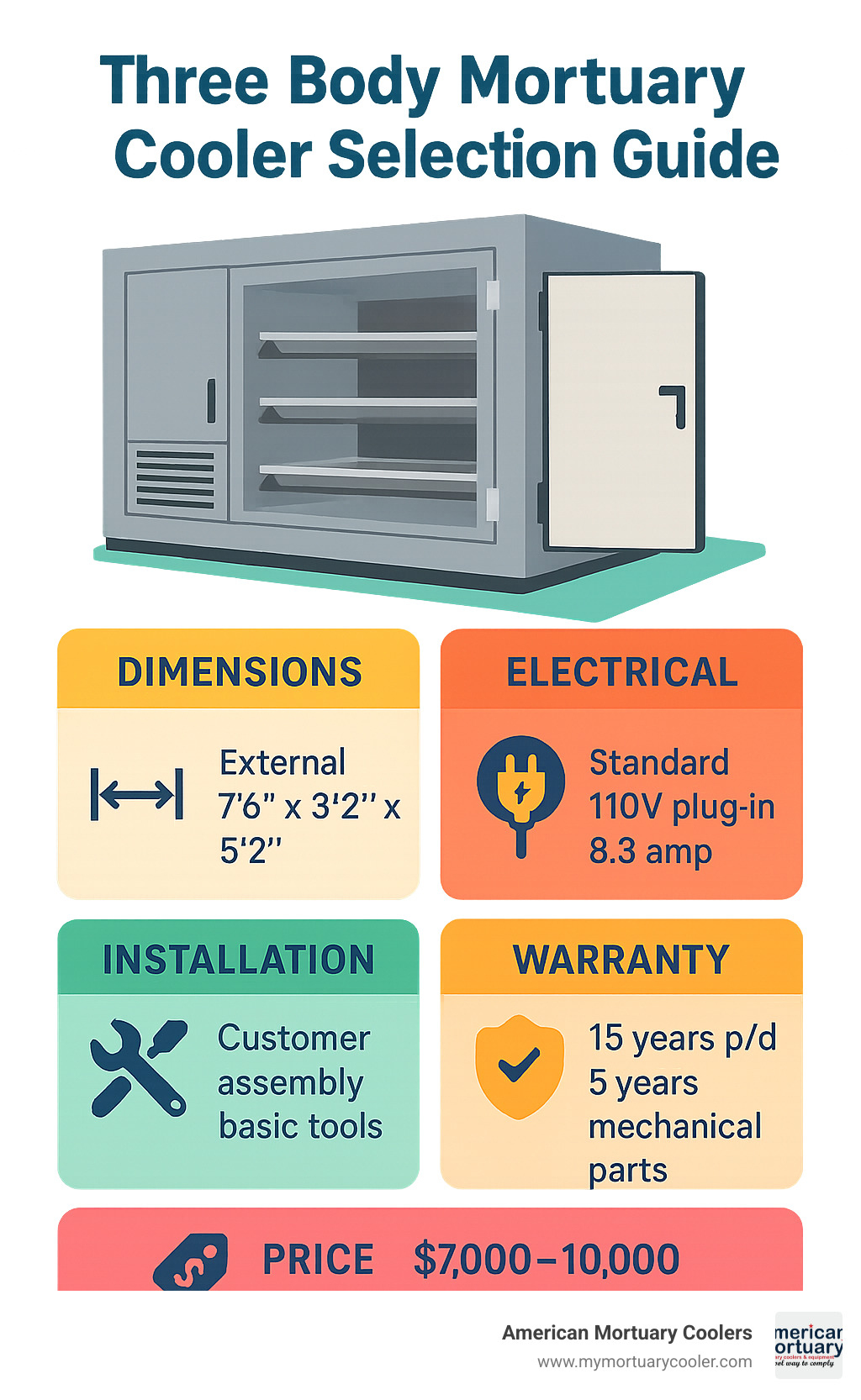
Three body mortuary cooler vocab to learn:
Understanding Mortuary Cooler Configurations
Choosing the right mortuary cooler feels a bit like finding the perfect pair of shoes – you need something that fits your space, handles your workload, and doesn't break the bank. The funeral industry offers everything from compact single-body units to massive walk-in systems, but most facilities find their sweet spot somewhere in the middle.
Think of it this way: a single-body cooler works great for small operations that rarely need more than one storage space at a time. But what happens during flu season or after a tragic accident? You're suddenly scrambling for additional storage. On the flip side, a four-body unit might seem like overkill for a rural funeral home that typically serves just a few families per month.
| Configuration | External Dimensions | Internal Capacity | Typical Users | Price Range |
|---|---|---|---|---|
| 1-Body | 4'6" × 2'8" × 4'2" | Single tray | Small facilities | $4,000-$6,000 |
| 2-Body | 7'3" × 3'¾" × 5'2" | Two-tier rack | Rural morgues | $6,000-$8,000 |
| 3-Body | 7'6" × 3'2" × 5'2" | Three-tier rack | Most funeral homes | $7,000-$10,000 |
| 4-Body | 8'2" × 3'6" × 6'0" | Four-tier rack | Large facilities | $9,000-$12,000 |
The beauty of modern mortuary coolers lies in their upright cabinet design, which stacks storage vertically rather than eating up precious floor space. You'll also find roll-in boxes that accept gurneys directly, and side-load racks for tight spaces where front access isn't practical.
Energy efficiency has come a long way in recent years. Today's units feature thicker insulation and smarter compressors that keep your electric bills reasonable while maintaining precise temperature control. The difference between an older unit and a new one can save you hundreds of dollars annually in operating costs.
Here's something that surprises many first-time buyers: most three body mortuary coolers are designed for customer installation. No need to hire specialized technicians or wait weeks for a service call. With basic tools and about two hours of your time, you can have your new cooler up and running.
Why Consider a Three Body Mortuary Cooler?
The three body mortuary cooler hits that perfect balance between capacity and practicality. After working with hundreds of funeral homes across the country, we've found that three-body units handle about 80% of operational scenarios without wasting space or money.
Rural morgues particularly benefit from this configuration. You might go weeks with just one occupant, then suddenly need to accommodate three during a difficult period. The three-body capacity provides that crucial buffer without the ongoing costs of a larger system.
Hospitals love how these units fit into existing morgue spaces. Most hospital morgues weren't designed with expansion in mind, so the compact footprint of a three-body cooler often makes the difference between upgrading successfully or having to relocate equipment.
Funeral homes find the space optimization invaluable when staging multiple services. You can prepare for a busy weekend while maintaining the dignity and organization that families expect.
Types of Three Body Units on the Market
When shopping for a three-body cooler, you'll encounter several distinct styles, each designed with specific operational needs in mind.
Upright cabinet style units dominate the market for good reason. These vertical designs feature three stacked compartments with telescoping roller shelves that glide out smoothly for easy access. The self-contained design plugs into any standard 110V outlet – no special electrical work required.
Roll-in box style coolers cater to facilities that prioritize transport efficiency. These units accommodate gurneys and stretchers directly, eliminating the need to transfer remains onto storage boards. Hospitals particularly favor this approach because it reduces handling and speeds up the intake process.
Side-load rack systems solve space challenges in creative ways. Instead of opening from the front, these units provide access from the side. They're perfect for narrow corridors or when you need to place the cooler against a wall.
Walk-in kit configurations use modular panels to create custom storage areas. While less common for three-body capacity, some facilities choose this approach when they anticipate future expansion or need non-standard dimensions.
Each style has its place, but the traditional upright cabinet remains the most popular choice for its reliability, efficiency, and ease of installation. For more detailed information about the various options available, check out More info about different coolers.
Key Specifications of a Three Body Mortuary Cooler
When you're shopping for a three body mortuary cooler, the technical details matter more than you might think. These aren't just big refrigerators - they're precision-engineered units designed to maintain the exact conditions needed for dignified care.
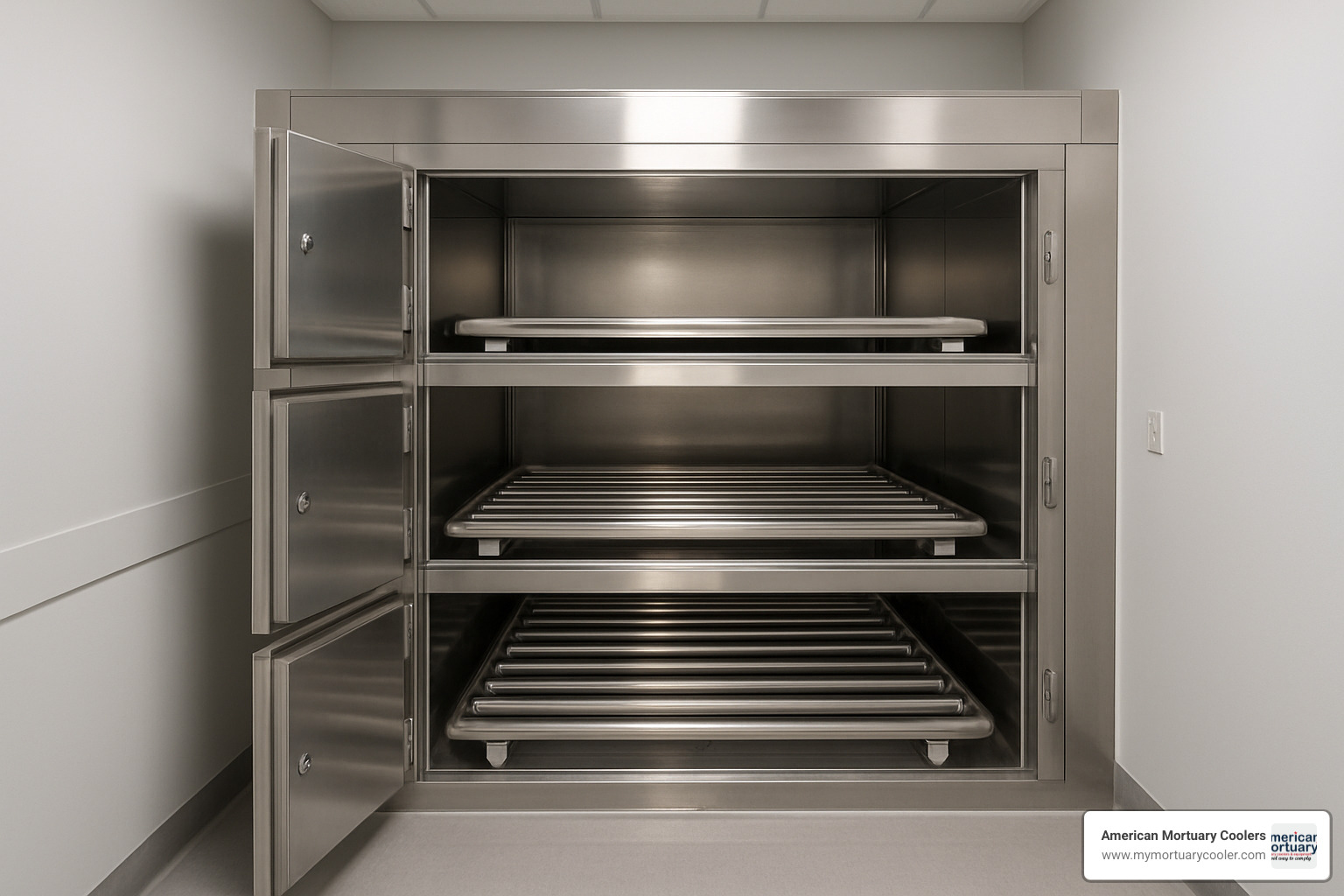
The sweet spot for temperature control sits between 36°F and 39°F. This range isn't random - it's carefully calculated to slow decomposition while preventing tissue damage from freezing. Too cold, and you risk tissue damage. Too warm, and preservation suffers.
Modern units come with digital controllers that take the guesswork out of temperature management. You'll see the exact temperature at a glance, and many models will sound alarms if something goes wrong. Power outage? Door left open? You'll know immediately.
The insulation system is where quality really shows. Look for polyurethane foam panels with R-values between 21 and 28. Higher R-values mean better insulation, which translates to lower electric bills and more stable temperatures.
Standard Dimensions of a Three Body Mortuary Cooler
Here's where the engineering really shines. A standard three body mortuary cooler measures about 7'6" deep by 3'2" wide by 5'2" high on the outside. The internal space gives you 6'11" by 2'7" by 4'6" to work with.
These dimensions aren't arbitrary. They're designed to fit through standard doorways during delivery while maximizing your storage space. Think of it as fitting a full mortuary solution into roughly the same footprint as a large household refrigerator.
Tray width options typically include 23", 27", and 30" configurations. Most facilities go with the 30" width because it accommodates average-sized individuals comfortably while still fitting within the unit's overall dimensions.
If you need flexibility, optional casters can make your unit mobile. Most installations stay put, but having the option to move things around during renovations or for temporary needs can be valuable.
Electrical & Temperature Specs for Three Body Mortuary Coolers
The beauty of most three body mortuary coolers lies in their simplicity. They run on standard 115V power and draw about 8.3 amps - meaning you can plug them into a regular outlet. No special electrical work required.
The 1/3 horsepower compressor delivers 2,610 BTUH of cooling power. That's plenty for maintaining proper temperatures under normal conditions. Just keep in mind that these units work best when the room temperature stays below 95°F.
Digital temperature controllers keep things precise within about ±1°F. These smart systems handle defrost cycles automatically and protect the compressor from damage. Some even connect to monitoring systems that can alert you remotely if something goes wrong.
The plug-and-play design is a game-changer for smaller facilities. No electrician needed, no special permits - just plug it in and you're ready to go.
For a comprehensive selection of three-body options, visit our Mortuary Cooler 3 Body collection.
Construction & Materials That Matter
Quality construction isn't just about looking professional - it's about reliability when you need it most. In mortuary care, equipment failure isn't just inconvenient; it's unacceptable.
The exterior construction uses galvanized steel with powder-coated finishes that resist rust and corrosion. Heavy-duty chrome-plated hardware handles the daily wear and tear of frequent use. The door hinges are reinforced because they're supporting significant weight when shelves are loaded.
Interior materials feature Type 304 stainless steel throughout. This isn't just for looks - the smooth, non-porous surface makes cleaning and sanitizing straightforward. Health departments require this level of cleanliness, and stainless steel delivers.
Insulation thickness ranges from 3" to 4" of polyurethane foam, giving you those R-values between 21 and 28 we mentioned earlier. Thicker insulation costs more upfront but pays dividends in energy savings and temperature stability over time.
The sealing system uses magnetic gaskets that create airtight seals while still allowing easy door operation. These self-sealing doors maintain temperature integrity even with frequent access throughout the day.
LED lighting provides bright, even illumination without generating excess heat. The vapor-proof fixtures include exterior switches and pilot lights, so you can see if the interior light is on without opening the door.
For detailed comparisons and selection guidance, review our An Essential Guide to Comparing 3 Body Mortuary Coolers.
Buying Considerations & Custom Options
Choosing the right three body mortuary cooler goes beyond just comparing specs on paper. You'll want to think through several practical considerations that can make or break your investment decision.
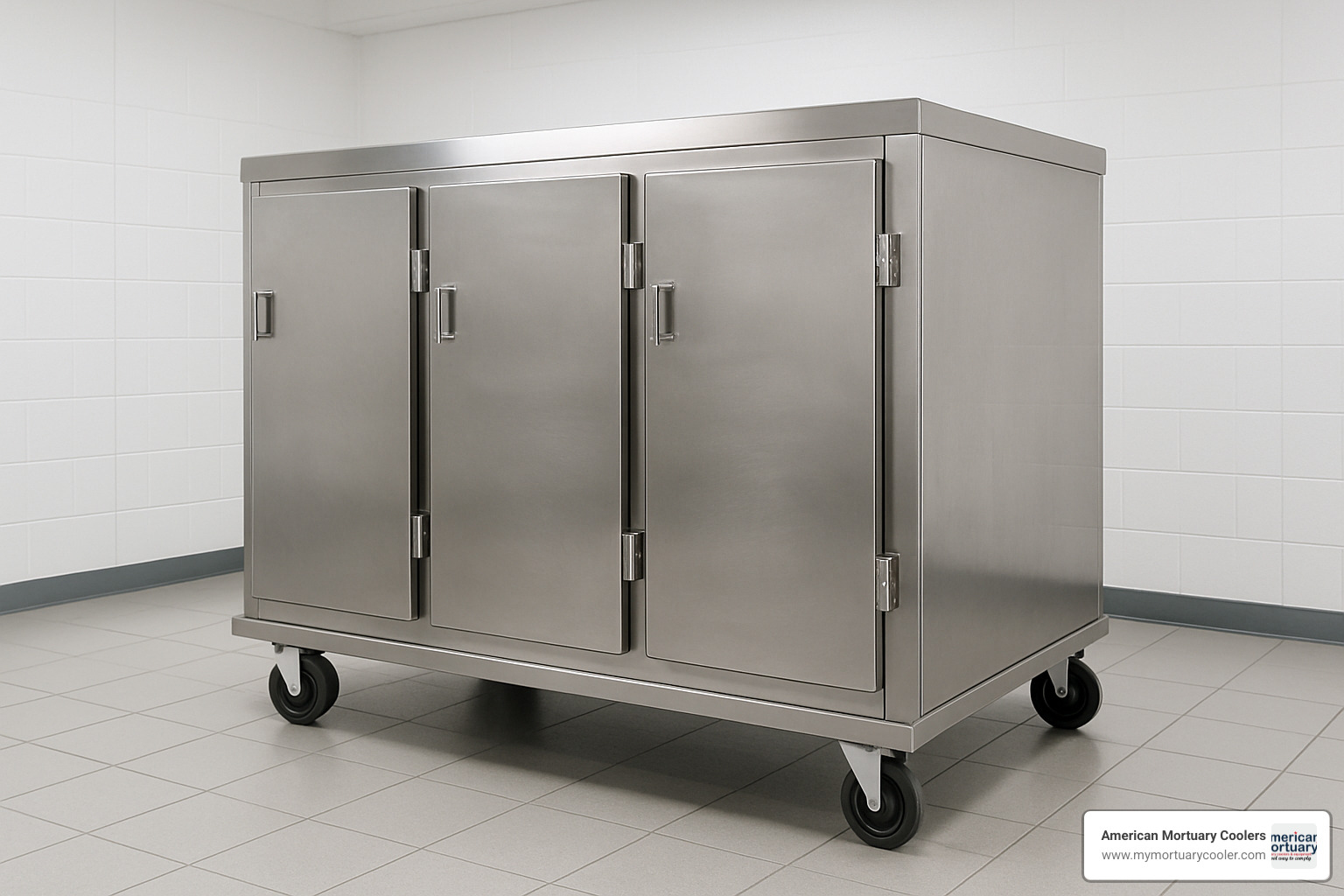
Site preparation is surprisingly straightforward for most facilities. You'll need a level floor and enough clearance for the doors to swing open fully. The good news? These units don't require extensive site prep like some larger mortuary equipment.
The floor choice deserves some thought. You can get units with or without insulated floors, depending on your facility's needs and local building codes. Insulated floors boost energy efficiency but add to the overall height of the unit.
Here's something that pleasantly surprises many buyers: assembly takes just 1.5 to 2 hours. The cam-lock system makes it surprisingly manageable, even if you're not particularly handy. Most funeral directors find they can handle the installation themselves with basic tools.
Financing can be a real game-changer for smaller operations. Many suppliers offer 90-day no-payment terms for qualified buyers, which helps with cash flow planning. Plus, if your business spends less than $2,000,000 on equipment annually, you might qualify for Section 179 tax deductions of up to $500,000 in a single tax year.
Customization options let you tailor the unit to your facility's specific needs. Color finishes beyond standard white or almond are available if you want to match your existing décor. The choice between roller versus slide shelves affects daily operations more than you might expect. Roller systems make accessing remains much easier, especially when you're working alone.
Security locks are worth considering if you need to maintain strict chain of custody or limit access to authorized personnel only. They provide peace of mind and help meet regulatory requirements in some jurisdictions.
Installation Requirements & Delivery Tips
Getting your three body mortuary cooler delivered and set up properly starts with understanding what you're getting into. These units typically weigh enough to require forklift unloading, so make sure you have access to one or arrange for lift-gate delivery.
If you don't have a forklift available, the lift-gate fee is usually worth it for the convenience. Just remember you'll need enough people on hand for manual unloading – these aren't one-person jobs.
The cam-lock assembly system is designed with funeral directors in mind, not engineers. You'll need basic tools like a power drill, socket wrenches, a level, and a rubber mallet. The specialized wrenches usually come included.
One major advantage: no plumber needed. These self-contained units don't require drainage connections, which saves both time and money during installation. Just make sure your electrical circuit can handle the 8.3-amp draw without overloading.
Ambient temperature limits are crucial to understand. If your facility regularly exceeds 95°F around the unit location, you'll void the warranty and compromise performance. In hot climates, consider upgraded compressors or improved ventilation around the installation area.
Budget & Warranty Comparison
Three body mortuary cooler pricing typically falls between $7,000 and $10,000, which represents solid value for the capacity and features you get. Basic models start around $7,400, while units with premium features like upgraded compressors or custom finishes can push past $9,500.
The warranty coverage reflects the quality you're getting. Most manufacturers offer 15 years on panels and doors, 5 years on mechanical components, and 2 years on parts and labor. These aren't short-term investments – they're built to serve your facility for many years.
Operating costs vary significantly based on insulation quality and your local climate. Units with R-28 insulation can cut energy consumption by 20-25% compared to R-21 systems. That might not sound like much, but it adds up over the 15+ year lifespan of the unit.
The financing options available today make these units accessible even for smaller funeral homes operating on tight budgets. Many suppliers offer 0% down payment plans with deferred payment options, letting you preserve cash flow while getting the equipment you need.
Operating, Maintenance & Compliance Essentials
Keeping your three body mortuary cooler running smoothly isn't rocket science, but it does require consistent attention to a few key areas. Think of it like caring for any important piece of equipment – a little regular maintenance goes a long way toward preventing those middle-of-the-night emergency calls.
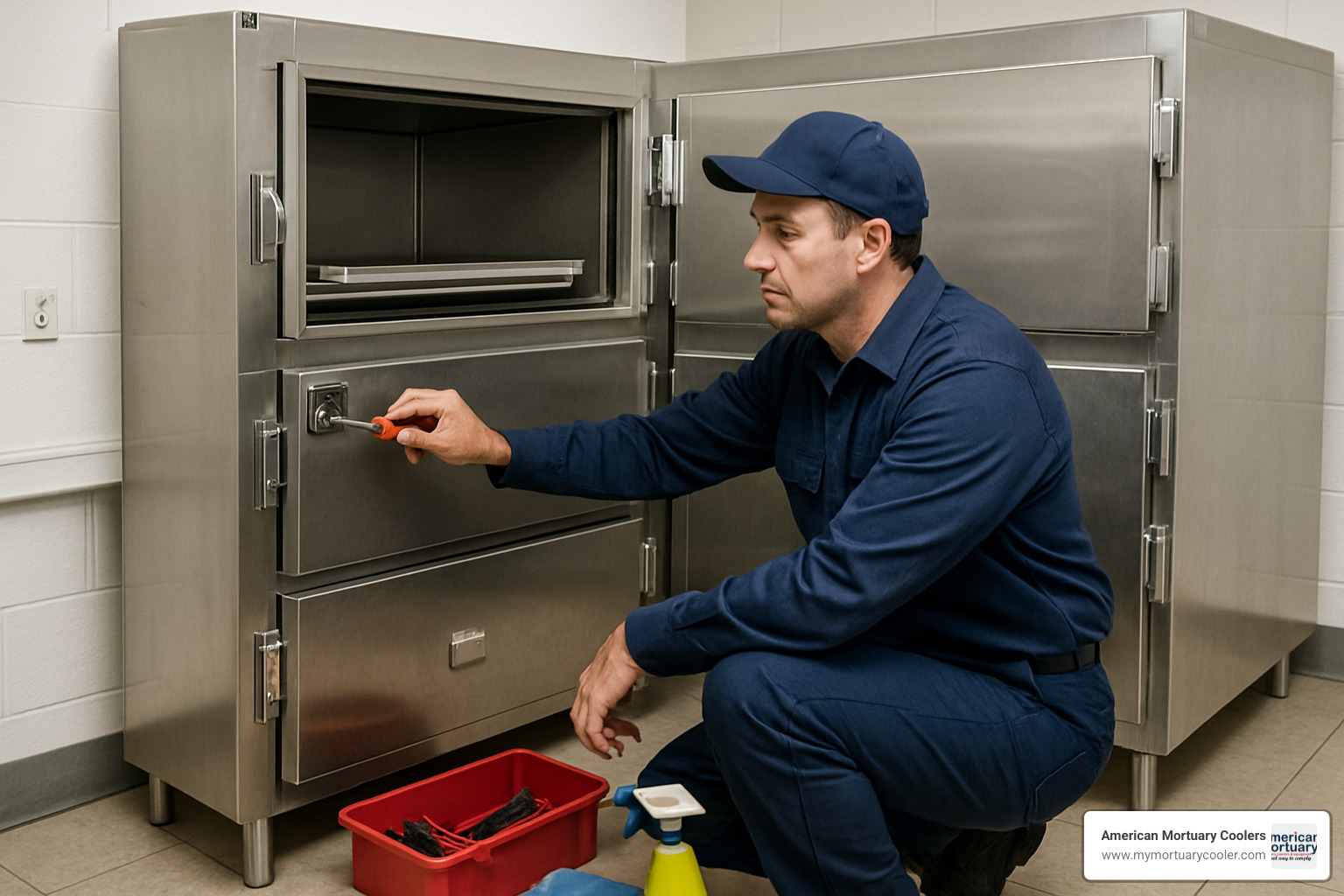
The foundation of good maintenance starts with cleaning schedules that work with your facility's daily routine. Most health departments expect daily cleaning of interior surfaces with approved disinfectants – it's not just about compliance, it's about maintaining the dignified environment families expect. Weekly deep cleaning involves removing the shelving system completely and giving everything a thorough sanitization.
Gasket inspection might seem like a small detail, but those rubber seals around the doors are working hard every day. Check them monthly for cracks, tears, or hardening. When gaskets start failing, your cooler works overtime to maintain temperature, and your electric bill shows it. Replace worn gaskets promptly – they're inexpensive compared to the energy waste they cause.
Your condenser coils need breathing room to do their job effectively. Dust and debris act like a winter coat on these coils, making the compressor work harder than necessary. A monthly cleaning with a soft brush or compressed air keeps everything running efficiently and extends the life of your equipment.
The regulatory side involves several important certifications. NSF/ANSI #7 compliance ensures your cooler's panels meet both food service and mortuary industry standards. UL-listed components provide safety assurance for electrical and refrigeration systems, often required by local codes and insurance policies.
EISA 2007 compliance addresses energy efficiency requirements that help reduce your operating costs while meeting environmental standards. Staff safety considerations include proper lifting techniques and considering optional mortuary lifts for heavier remains – your staff's long-term health is worth the investment.
Energy Efficiency & Running Costs
The biggest factor affecting your three body mortuary cooler's energy consumption is insulation thickness. Units with 4-inch panels (R-28 insulation) typically use 20-25% less energy than those with 3-inch panels (R-21). That difference adds up quickly on your monthly utility bills.
Your local climate plays a huge role in operating costs. Facilities in hot, humid areas like Florida or Arizona see higher energy consumption because the cooler works harder against the ambient heat. Good ventilation around your unit helps, but there's only so much you can do about Mother Nature.
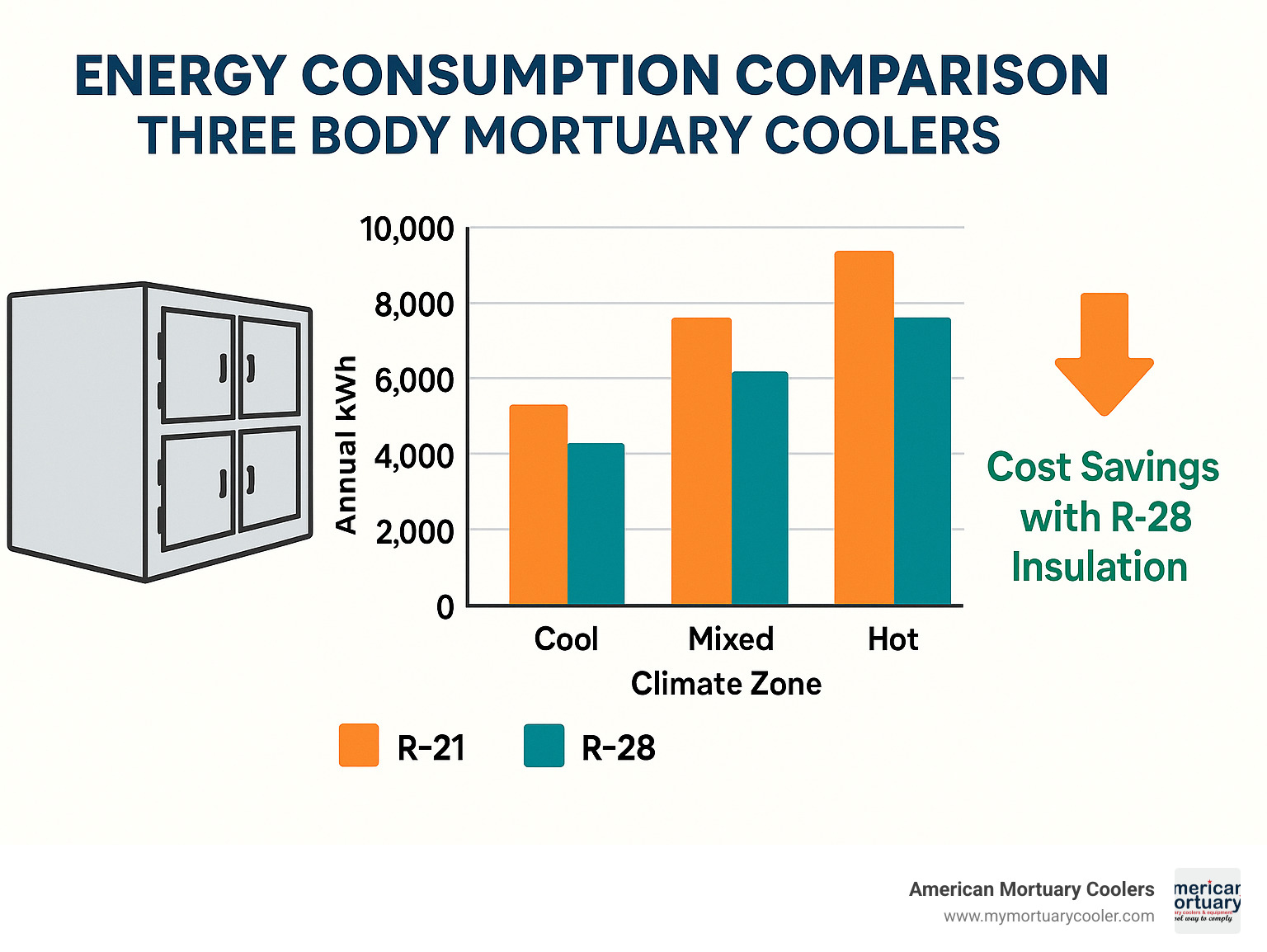
The math on better insulation is pretty straightforward – the energy savings typically pay for the upgrade cost within 2-3 years in most climate zones. Factor in your local utility rates and expected usage patterns to see if the upgrade makes sense for your situation.
For more detailed information about energy considerations and cost calculations, check out our comprehensive guide on Threebodymortuarycooler.
Regulatory & Safety Certifications
OSHA guidelines cover workplace safety in mortuary operations, including proper equipment operation and maintenance procedures. This means ensuring your staff knows how to operate the cooler safely and what to do if something goes wrong.
State health codes vary significantly from state to state, but most require some form of temperature monitoring, cleaning protocols, and equipment certification. Some states are stricter than others – California and New York tend to have more detailed requirements than rural states.
Temperature logs document that you're maintaining proper storage conditions and demonstrate compliance during inspections. Modern digital controllers with data logging capabilities make this much easier than the old paper-and-pencil method.
Data alerts from advanced monitoring systems can be lifesavers – literally. These systems notify staff immediately when temperatures drift out of range, power fails, or equipment malfunctions. While not required everywhere, they provide peace of mind and help prevent losses that could impact families during their most difficult times.
Frequently Asked Questions about Three Body Mortuary Coolers
How long does self-assembly take and what tools are needed?
Setting up your three body mortuary cooler is surprisingly straightforward - most customers complete assembly in about 1.5 to 2 hours with a helper. The cam-lock system is designed specifically for customer installation, so you won't need to hire specialized contractors.
You'll need some basic tools that most facilities already have on hand: a cam-lock wrench (we include this with your order), a power drill with standard bits, a socket wrench set, a 6-foot level, a rubber mallet, and a tape measure. Nothing fancy or expensive required.
The process involves connecting the pre-fabricated panels using those cam-lock fasteners, installing the shelving systems, and plugging in the electrical components. We provide detailed step-by-step instructions, and our team is always available by phone if you hit any snags during setup.
Many customers tell us they're surprised how manageable the installation process is. One funeral director recently shared, "I was worried about assembly, but it went together like a well-designed piece of furniture - just bigger and more important."
Can I upgrade the compressor for hot climates?
Absolutely - and we strongly recommend it if your facility deals with ambient temperatures above 95°F. Standard compressors work great under normal conditions, but exceeding that 95°F limit can void your warranty and leave you with unreliable cooling when you need it most.
Our upgraded compressors handle ambient temperatures up to 110°F while providing increased cooling capacity and improved reliability. They feature improved condenser systems specifically designed for challenging climate conditions.
The upgrade typically adds $300 to $800 to your order, depending on your specific requirements. When you're dealing with the responsibility of proper preservation, this investment pays for itself through reliable operation and peace of mind.
Be sure to mention your local climate conditions when ordering. We've worked with facilities from Arizona deserts to humid Louisiana summers, so we understand how local conditions affect equipment performance.
What financing options are available for small funeral homes?
We understand that smaller funeral homes often need to be creative with equipment purchases, which is why we've developed several financing solutions that work with real-world budgets.
Our 90-day no-payment programs give you time to integrate the unit into your operations before payments begin. Many facilities appreciate having their three body mortuary cooler generating revenue before the first payment is due.
Section 179 tax deductions can be particularly valuable - if your business spends less than $2,000,000 on qualified equipment annually, you can potentially write off the full purchase price in the year you buy rather than spreading depreciation over multiple years. That's a significant cash flow advantage for most funeral homes.
We also offer 0% down payment options and work with equipment financing companies that understand the funeral industry. These lenders know your business model and can structure payments that align with your cash flow patterns.
Lease-to-own programs provide another path for facilities that prefer to spread costs over time while building equity in the equipment. Credit requirements vary, but we've found solutions for businesses with different financial profiles.
The key is starting the conversation early. Our team can walk you through the options and help you find an approach that fits your specific situation and budget constraints.
Conclusion
Choosing the perfect three body mortuary cooler is more than just picking equipment—it's about investing in your facility's ability to provide dignified, professional care. After years of helping funeral professionals across the country, I've seen how the right cooler choice transforms daily operations while honoring those we serve.
The journey to selecting your ideal unit starts with understanding your specific needs. Space optimization remains the top priority for most facilities, and three-body units deliver that sweet spot between capacity and footprint. Whether you're running a rural county morgue handling seasonal fluctuations or a busy funeral home managing multiple services, these units adapt to your workflow.
Energy-smart design features make modern three-body coolers surprisingly efficient. The difference between R-21 and R-28 insulation might seem small, but over 15+ years of operation, that choice impacts both your utility bills and environmental footprint. Many of our clients find the energy savings pay for insulation upgrades within just a few years.
At American Mortuary Coolers, we've built our reputation on understanding that no two facilities are exactly alike. Based right here in Tennessee, we craft custom mortuary coolers that meet your specific requirements, then deliver them directly across all 48 contiguous states. From the mountains of Colorado to the coastal regions of California, we've helped facilities create reliable, dignified storage solutions.
Installation simplicity sets these units apart from complex built-in systems. The plug-and-play design means you can have professional mortuary refrigeration running in under two hours with basic tools. No waiting for contractors, no specialized electrical work—just straightforward assembly that gets you operational quickly.
Dignified storage isn't just about temperature control—it's about creating systems that support your staff and honor families during difficult times. The smooth operation of roller shelving, the reliability of digital controls, and the peace of mind from comprehensive warranties all contribute to that goal.
Your three body mortuary cooler represents a long-term partnership with your facility's mission. With proper care, these units provide decades of reliable service, supporting countless families through their most challenging moments.
Ready to explore your options? Our team understands the unique challenges facing funeral professionals today. We're here to help you find the perfect balance of capacity, efficiency, and reliability for your specific situation.
For more comprehensive information about mortuary cooling solutions and to explore our full range of products, visit More info about mortuary coolers.


















